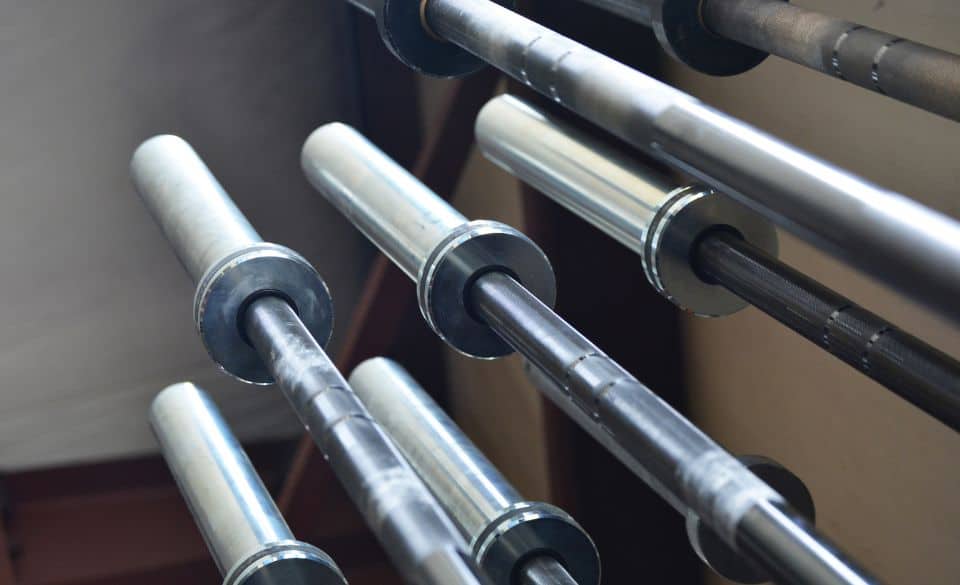
Common Barbell Types & Their Purpose
Page Contents
Each gym will have a barbell – the question is – Which kind of barbell are we talking about? I’ll cover all the common barbell types & their purpose. And tell you which ones you’ll certainly find in any gym. In fact, if you walk into a gym right now and don’t see at least one barbell – run! I don’t know where you were at that moment, but chances are that wasn’t a gym.
Anyway, several barbells are available, each providing a specific function. I’ll go through all of them here, but I’ll concentrate on the most frequent varieties of barbells you’ll come across or utilize.
There is a barbell that can help you reach your objectives whether you want to boost your general strength, grow muscle, or improve your sports performance. You can take your exercise to the next level with the suitable barbell.
So, let’s take a closer look at what that barbell may be!
What are the common types of barbells?
The standard and Olympic barbells are the most common ones that you will encounter. There are a few other more common ones, but I’ll cover these two first.
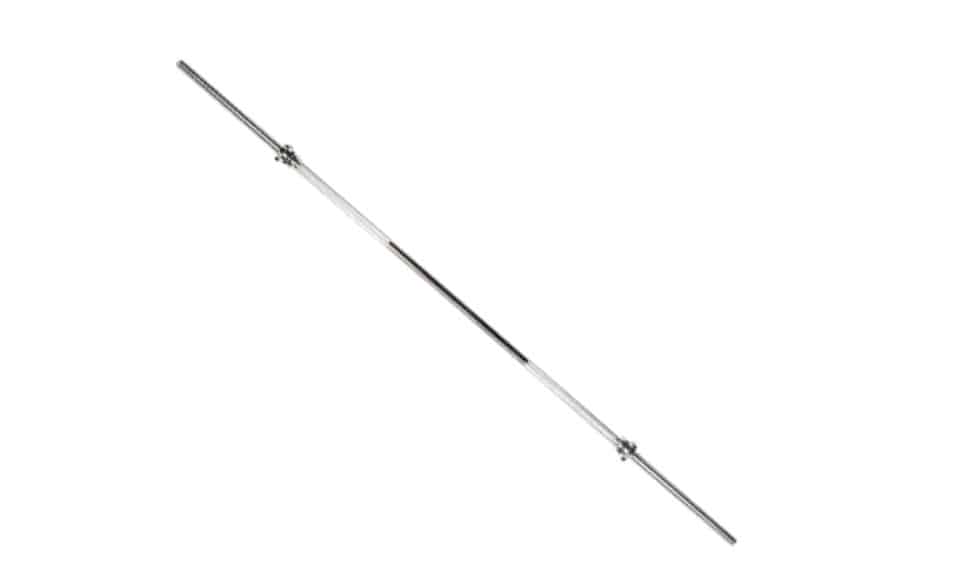
Standard barbell
– Material: Iron, Steel, Steel Alloy, Aluminum
– Length: 5-6 ft (1.5-1.8 m)
– Weight: 15-25 pounds (7-11kg)
For which exercises is a standard barbell used?
– Squats
– Deadlifts
– Bench press
– Standing military press (Shoulder press)
– Rows
– Curls
– Lunges
– Rollouts
It’s the most common kind of barbell seen in fitness centers, standard barbells are a great place to start your barbell exploration.
It was the first barbell that was ever created. Each of the many different kinds of barbells is a variation of the standard barbell and is designed for a specific exercise routine.
The only limitation on the number of exercises you may do with a standard barbell is your creativity. I have included a list of typical exercises that can be performed with a standard barbell; however, you may significantly extend your training regimen.
As long as you pay attention to your health and safety and complete the exercises correctly, the workout should be practical and fruitful.
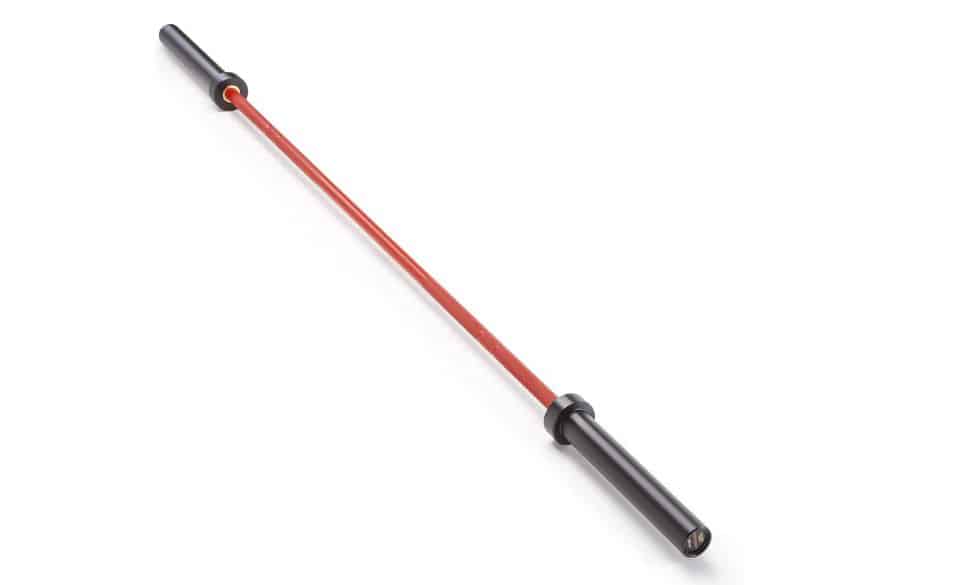
Olympic barbell
Material: High-quality steel, Steel Alloy
Length: 7.2 ft (2.2 m)
Weight: 45 pounds (20 kg)
For which exercises is an Olympic barbell used?
– Snatch
– Deadlifts
– Clean and jerk
– Squat
– Bench press
Olympic barbells are designed for Olympic weightlifting, hence the name. They are created using the highest quality steel to endure much more weight on them without bending or breaking, even after repeated usage. Its 28 mm (men’s size) and 25 mm(women’s size) diameter makes it more robust than a standard barbell.
Men’s barbells weigh 20 kg (44 lbs), and women’s 15 kg (33 lbs). Its spinning sleeves let plates spin freely, eliminating wrist and forearm strain during snatches, cleans and jerks. Weightlifting, powerlifting, and strength training employ Olympic barbells. Rows, and presses & curls are also possible with the Olympic barbell.
These two are the most common different barbell types that you can encounter. And if you ever saw a barbell, there is a high chance that it was one of these two.
However, there are many other barbell variations that you can encounter, and since this article is all about commonality, I’ll also cover other more common barbells that you can find, as well as only mention other uncommon ones that exist near the end.
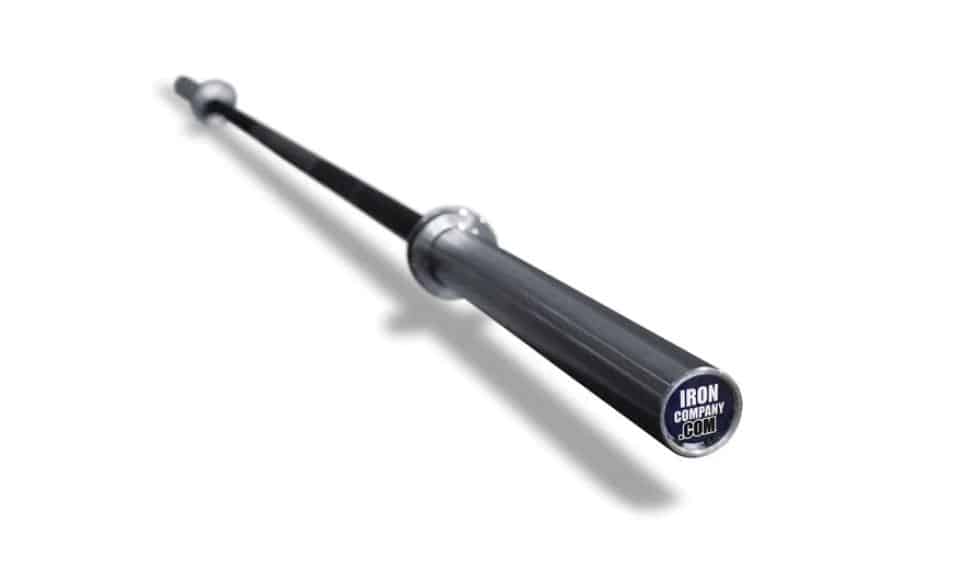
Powerlifting barbell
Material: Iron, Steel, Steel Alloy
Length: 7.2 ft ( 2.2 m)
Weight: 45 pounds (20 kg)
For which workouts is a powerlifting barbell used?
– Squats
– Deadlifts
– Bench press
A powerlifting barbell is typically used for the three main lifts in powerlifting: the squat, deadlift, and bench press. These exercises are known for their high weight loads and focus on overall strength and muscle development.
Some of the exercises that can be performed with a powerlifting barbell include squats (back squats, front squats, etc.), deadlifts (conventional, sumo, and more), bench presses (flat, incline, and decline), rows (bent-over, t-bar, and more), presses (shoulder press, push press, etc.), and good mornings.
Powerlifting barbells usually have a diameter of 29 mm thicker than an Olympic barbell and have a tensile strength of 190,000 PSI. They are also designed to be stiffer and more rigid to handle heavy loads typically used in powerlifting. Due to the high weight loads and the focus on overall strength and muscle development, powerlifting barbells are usually found in commercial or specialized powerlifting gyms rather than home gyms.
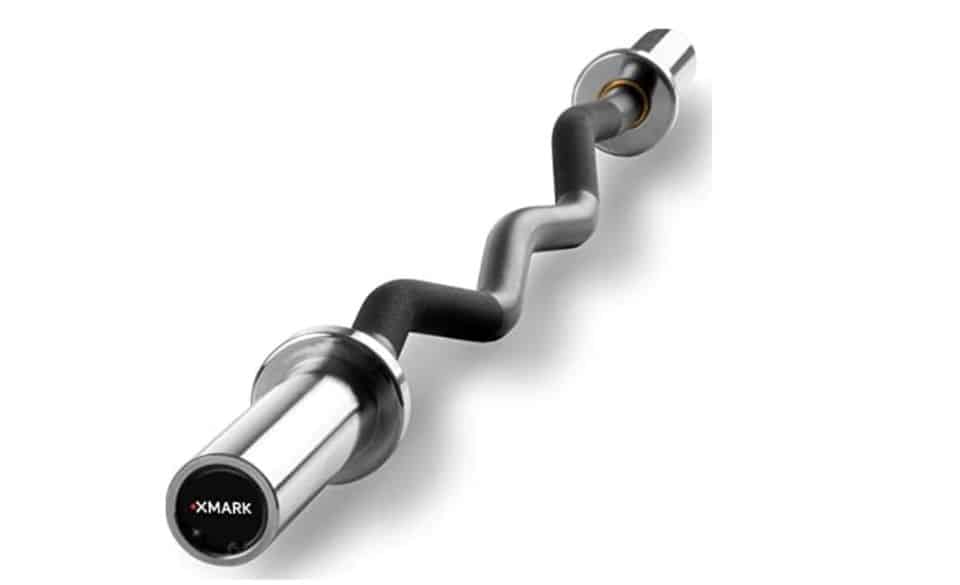
EZ curl barbell
Material: Iron, Steel, Steel Alloy, Aluminum
Length: 47’’ ( 1.2 m)
Weight: 15-25 pounds (7-11 kg)
For which exercises is an EZ Curl bar used?
– Bicep curls
– Tricep curls
– Hammer curls
– Preacher curls
– Reverse curls
– Wrist curls
– Lying tricep extensions
The EZ curl bar, or “easy curl bar”, is another common kind of barbell seen in the average gym. It was explicitly designed to strengthen the biceps and forearms.
The barbell is curved in the middle and has slanted grips so that the user can take a more relaxed and natural position when lifting.
Rather than being used for tough workouts, EZ curl bars are typically used for isolation exercises. Single-muscle-group workouts target a specific set of muscles with fewer loads than complex exercises.
Those who wish to bulk up their biceps and sculpt their forearms may do it with the help of EZ curl bars. These bars may be found in almost every home and commercial gym.
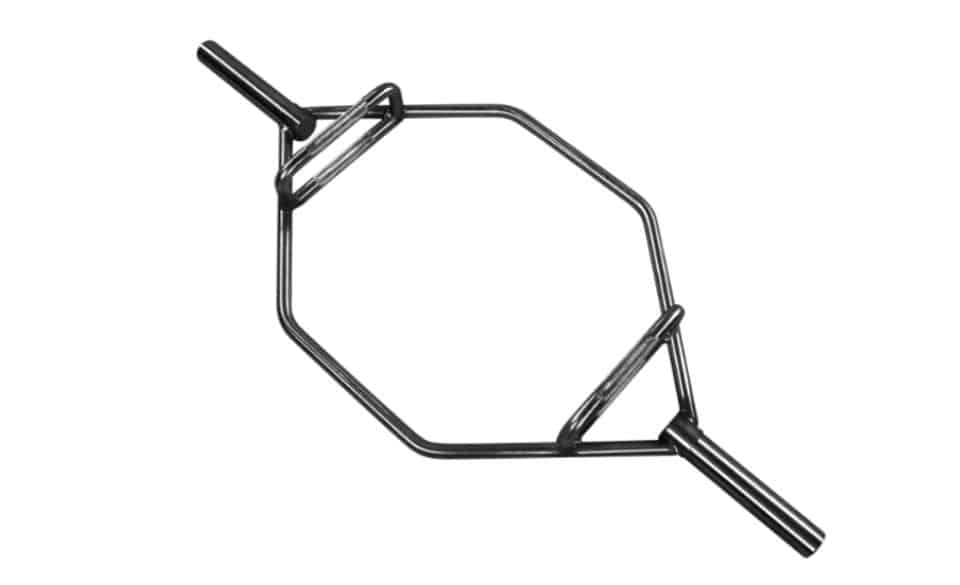
Hex barbells
Material: Steel, Steel Alloy, Aluminum
Length: 55’’-89’’ (1.4-2.2 m)
Weight: 40-100 pounds (18-45 kg)
For which exercises is a Hex barbell used?
– Deadlifts
– Shrugs
– Squats
– Lunges
– Farmers Walk
– Carry
A hex bar, also known as a trap bar, is a type of barbell that is shaped like a hexagon and has handles on the inside and outside of the hexagon. This allows the user to perform exercises with a neutral grip, which can be more comfortable and reduce strain on the joints.
Trap or hex bars are designed to make the following activities more accessible and effective: Hex bar deadlifts. They are a variation of traditional deadlifts, which allow for a more upright posture, reducing stress on the lower back.
Then you have shrugs, an effective exercise for targeting the trapezius muscles – a trap bar makes those much more convenient and comfortable. Next are hex bar squats, also known as trap bar squats, are a variation of traditional squats that allow for a more natural movement pattern and can reduce stress on the lower back. Hex lunges are a variation of conventional lunges that allow for a more natural movement pattern and can reduce knee stress.
Farmers Walk is a functional exercise that targets the grip, forearms, shoulders, and core. It can be performed by holding the hex bar by the handles and walking. A hex bar is also excellent for carries. This workout is a great exercise to improve grip strength, core stability, and shoulder stability.
Hex bars are typically used for compound exercises that target multiple muscle groups at once and are commonly found in commercial gyms and home gyms. They are great for those looking to build strength, power, and muscle mass.
So far, I’ve covered the standard barbell, the Olympic barbell, the EZ curl bar, the powerlifting barbell, and the trap/hex bar. And as it goes for how widespread different types of barbells are – these five would be the most common ones.
That doesn’t mean there aren’t more barbell types because there are many. I’ll briefly mention some less common barbell types that you can encounter:
– Women’s barbells
– Safety squat barbells
– Cross-training barbells
– Swiss barbells
– Log barbells
– Short barbells
Other different barbells exist, but if you’ve ever come across a barbell that is not one of the 5 I’ve covered above, it was almost certainly one of them.
FAQ
Can I use the standard barbell for any exercise?
While a standard barbell can be used for various exercises, it is not recommended for heavy lifting or use with high-weight loads. Standard barbells typically have a smaller diameter (25 mm), so keep that in mind because of the plates that go onto them. Standard barbells are less durable than Olympic or powerlifting barbells designed for heavy loads and frequent use. So if you want to go heavy – stick to Olympic or powerlifting bars.
A standard barbell can be used for exercises such as bicep curls, triceps extensions, shoulder presses, rows, etc. But for workouts like deadlifts, squats, bench presses, and Olympic lifts, an Olympic barbell or a powerlifting barbell would be a better option, as they are designed to handle the heavy loads and frequent use that these exercises require.
Also, standard barbells are built to different exacting standards than the Olympic or powerlifting barbells, so they can be less consistent in weight and balance, which can be a problem when working with high-weight loads.
It’s always recommended to use the right equipment for the proper exercise, especially with weights and barbells, to ensure safety and good form while lifting.
What is the difference between the standard barbell and the Olympic barbell?
Olympic barbells are larger and heavier than standard barbells, and their sleeves differ.
Olympic barbells are longer and thicker, having a 28 mm diameter instead of 25 mm. Olympic barbells contain spinning sleeves that enable plates to spin freely, decreasing wrist and forearm strain during clean-and-jerk workouts.
These bars are more robust and can take more weight than regular barbells. Home gyms employ standard barbells, which are not suitable for heavy lifting. Standard barbells are shorter and lighter, although they are 7.2 ft (2.2 m) long and weigh 45 pounds (20 kg) for males and 33 lbs (15 kg) for women.
Professional weightlifting contests use Olympic barbells, whereas home gyms and smaller fitness facilities use regular barbells.
Conclusion
Barbells are a vital piece of strength training equipment that comes in various forms, each of which has a unique function.
Olympic barbells may be used for various strength training routines, not only Olympic weightlifting. The Deadlift, Squat, and Bench Press are the cornerstones of powerlifting, and each requires a certain kind of barbell. Hex bars are fantastic for workouts that employ numerous muscle groups simultaneously, whereas EZ curl bars are better for isolating specific muscle groups and reducing joint stress.
While standard barbells have a wide range of training applications, they could be better for working with heavy weights. When weight training, it’s essential to use suitable equipment.
If you have experience with any barbell type, whether it’s the five most common ones or any of the less frequent ones, I’d love to hear your thoughts and opinions in the comment section below – especially if you’ve come across one that I haven’t mentioned!


